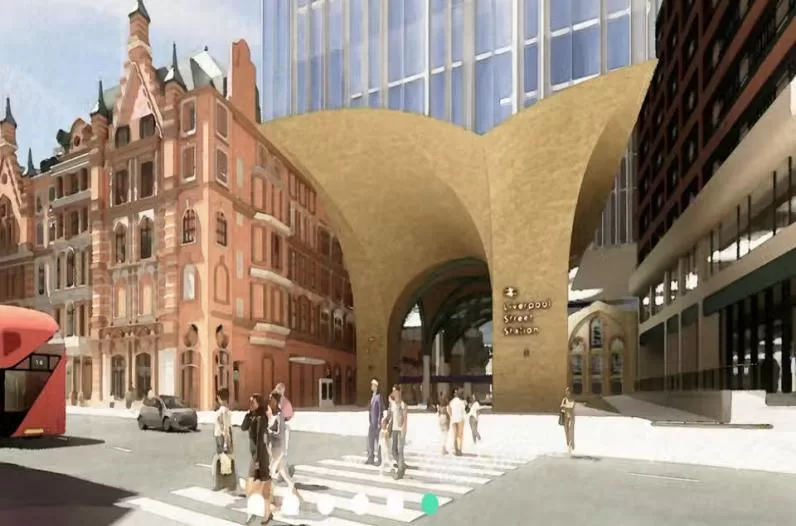£15bn proposal from Sellar out and Network Rail’s new plan proposal in – hopefully. The owner of Liverpool Street station, Network Rail, on the 4th of November, announced its plans for the redevelopment of Britain’s busiest station. The exclusive aim is the transformation of customer experience.
The 150 years old station offers an immense array of services to passengers. These range from the Elizabeth Line, to the Overground, the National Rail, and the Tube.
In the year spanning April 2022 to March 2023, the station recorded over 20 million more in user numbers compared to the 2nd and 3rd busiest stations – Paddington and Waterloo respectively, according to an article by Yahoo.
The ditched £15bn plan proposal by Sellar
Sellar had its (original) 2022 plan proposal include the installation of 16 floors on top of the Andaz hotel (formerly the Great Eastern Hotel). This would make the hotel stand at 21 floors up, closing up the view of St. Paul’s Cathedral.
The owner of the Liverpool Street station reported that it had withdrawn its support for Sellar’s proposal after a massive backlash from the public and heritage organizations. This was largely due to fact that the new design would “rob” the station of its historical facade.
Sellar, the developer for the tallest building in the UK, The Shard, was in collaboration with MTR Elizabeth Line and Hyatt Hotel Group. The former controls the hybrid urban-suburban rail – Elizabeth MTR, while the latter owns the mentioned Andaz hotel.

Also read Sellar’s Plans Unveiled for Liverpool Street Station Project in London
The new plan proposed by Network Rail
Liverpool street station new plan proposal by the station manager were announced with the remarks, “taking the lead” for the project, instead of having a developer (Sellar) pulling the strings. They mentioned the need for a “new team and new approach” – seemingly because they had backed the Sellar group in the first place. This is however equivocally inferred as Sellar’s planning application has not yet been removed from the City of London Corporation website.
Why is the project important?
The need for a revamp at the station comes in the light of prospective increase in passenger numbers by 2050, as put by the Group Property Director at Network Rail, Robin Dobson. He mentioned that the current passenger numbers stand at over 100 million and this is expected to surpass 150 million in just 40 years.
Expected changes
Major changes to the station will be a high-ceiling, gothic-cathedral facade and “four front” as put by Architect Friedrich Ludewig – the Founding Director of ACME. Surprisingly (or not), there will still be addition of floors above the Andaz. The new plan will however see only 13, and not 16 floors as Sellar had proposed.
Another development at the station to be scaled-back is the office tower block. It will stand at 97 meters in height, and not 108 meters as with Sellar’s proposal. The office block will also come with different specification. It will be of varying heights and with its corners pared down. This will ensure that St. Paul’s Cathedral is still in good sight. Along with that is the fact that it will not be built on the hotel, but from the back of the station.
Other major improvements to cater for a better everyday passenger experience include:
- 7 new lifts across the station and the underground
- 4 more escalators (increasing the total number 8)
- New toilets and family facilities
- Increased size of the concourse
- New entrances – on Bishopsgate, Exchange Square, and Liverpool Street
- More cycle storage, waiting lounges, cafes, restaurants, and space for passengers inside the station

The project stakeholders
According to Network Rail, the new faces handling the “new approach” will be the following:
- Shoreditch-based ACME – Architecture
- AECOM – Engineering & transport
- Certo – Project management
- Gerald Eve – Planning
- Gleeds – Cost manager
- Donald Insall Associates – Heritage & townscape
- GIA – Daylight and Sunlight
- JLL – Investment advice
- AVR London – Visualisations
- SLA – Landscaping
- Shared Voice – communications & engagement
- Intelligent Data Collection – Pedestrian modelling
- Mima Group – Accessibility & Inclusive design consultants
Liverpool Street Station project timeline
The plan is expected to reach the city corporation desks by the end of 2024, according to multiple trusted sources. If approved, construction plans for the facility are expected to start in two years time, as put by the Group Property Director at Network Rail. In his words – “There would be a start on-site in 2027/2028 and a five year project.” This makes the project completion date expected at 2032/2033.
Liverpool Street Station project cost
The project cost will be by the station itself, with a 450m pounds mark set by the project manager. In other words, the funding for the owner-led project will be generated from the very assets they own. Mr. Donson made clear the importance of the office building above the concourse. He named it the source for the, “self-funding of the new station”.
What happens to the station if construction begins?
Despite the minimum inconveniences caused by the project, the daily activities at the station will not be entirely affected as two platforms, 15 and 16, will be in operation. Consultations with the public, heritage groups – like the Victorian Society heritage group that would like to see the Victorian aesthetics still maintained at the station, and other stakeholders are still underway before the plan application submission is done.
Much is expected of this revamp at the Liverpool street station, with the spirit remaining positive for the plan proposals.
Also read about the One mile mark completed on Britain’s high speed rail tunnel

Leave a Reply